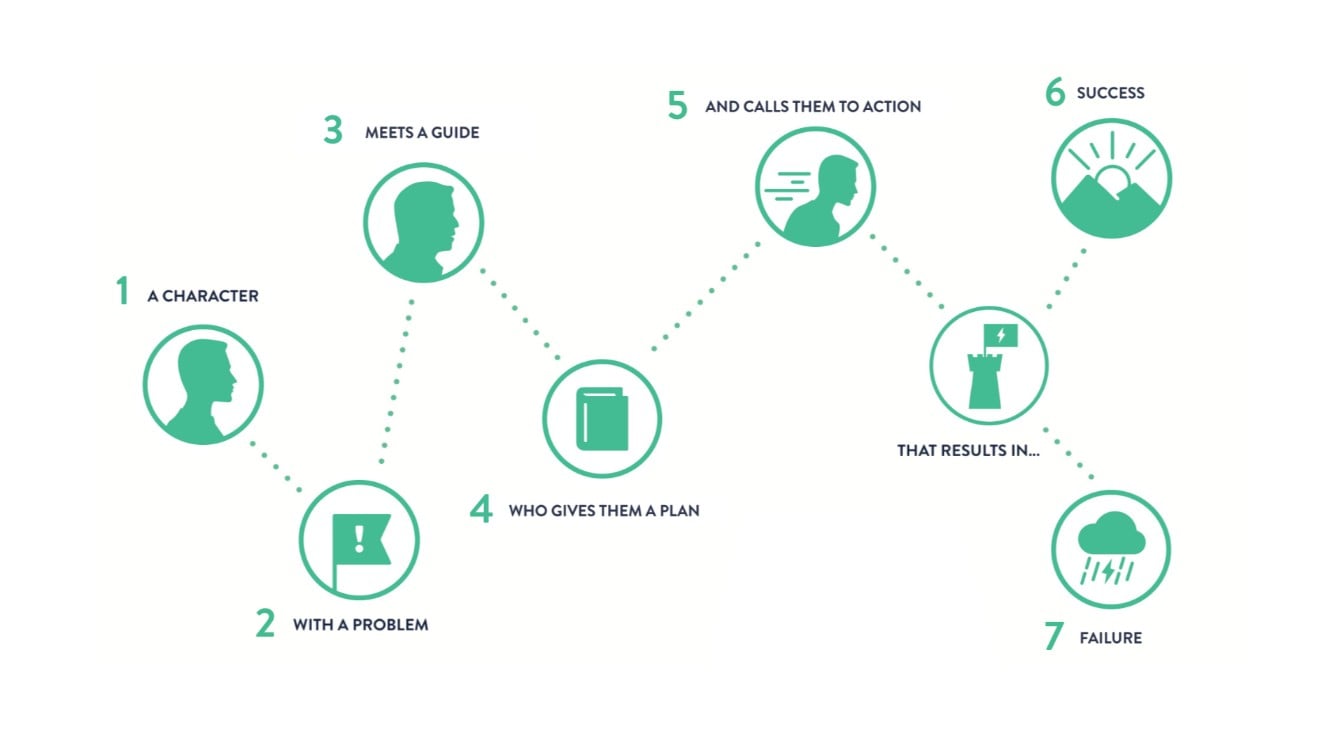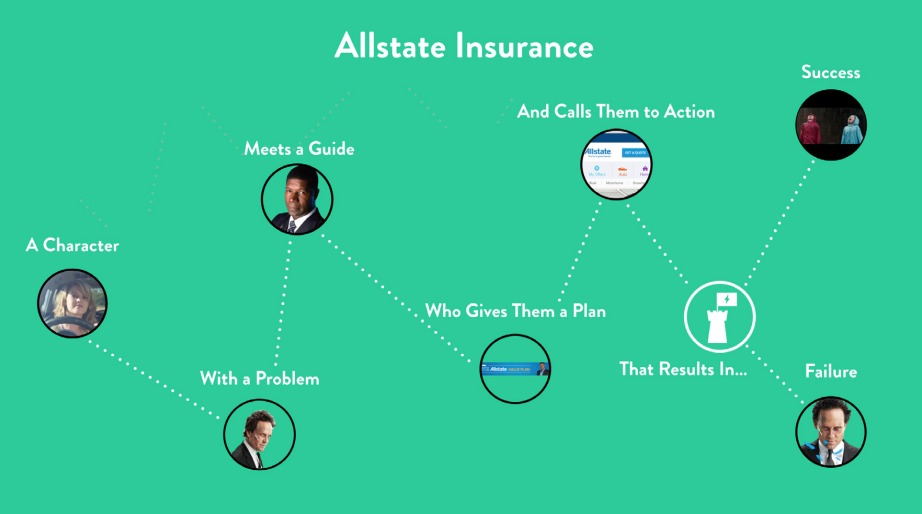Subscribe now and get the latest podcast releases delivered straight to your inbox.
What is the StoryBrand Framework? (As told by Dirty Dancing)

May 24, 2021

The StoryBrand Framework is a renowned approach to clarifying your marketing message where you explain what your business does through a relatable story.
It helps make your message easier to grasp and remember, using a seven-part structure based on a popular storytelling mechanism from books, movies, and songs called the hero’s journey — and in a marketing world that seems increasingly torn between data and creativity, I love that it shows the two can and should coexist.
You see, long before I even knew what marketing was, I fancied myself a storyteller. I relished creative writing through elementary school and, as a nerdy teen, secretly wrote fan fiction based on my favorite films and television shows.
I loved how stories could make you feel something, how you could have an experience without ever moving, and as I got older and became enamored with marketing, I learned just how valuable this power is in reaching an audience and making a sale.
What is the StoryBrand Framework?
The StoryBrand Framework was first created and introduced by Donald Miller in his 2017 book, Building a StoryBrand: Clarify Your Message So Customers Will Listen.
Originally a writer by trade, Miller developed the idea years ago when he began working in marketing and was looking for an easy, repeatable way to explain what a business does and why buyers should care.
Inspired by books, how many movie screenplays work, and even song lyrics, he then created a seven-part template based on Joseph Campbell’s The Hero’s Journey (more on that later) that essentially positioned customers as heroes facing a challenge in the story of their lives and brands as the guide or solution that helps them live happily ever after.
The 7 pieces of the StoryBrand Framework
For the StoryBrand Framework, Donald Miller simplified the hero’s journey into seven touchpoints.

Image Source: StoryBrand
Examples of this storytelling structure can be seen throughout some of the most iconic and well-known stories in the world. I was actually first introduced to it while reading the epic Hindu script, Bhagavad Gita, in my high school English class, but it’s also present in Hollywood blockbusters and Billboard Top 100 songs.
A popular example can be seen in the film Star Wars, but let’s walk through each point using one of my favorites — Dirty Dancing.
1. Meet the lead character (the “hero”)
At the beginning of almost every story, we’re introduced to a character who wants something; maybe it’s to “get the girl” or save the world. Regardless of what it is, it is unclear if and how this goal will be accomplished.
In Dirty Dancing, the hero is Frances “Baby” Houseman (played by Jennifer Grey), a young woman coming of age and trying to find herself.
2. Hero encounters a problem
Enter the conflict. Every great story has a conflict or problem that is standing in the way of the hero achieving their goal.
For Baby, it was her strict father and the social norms she was raised with.
3. Hero meets a guide
Next, the hero meets somebody, a “guide,” who can help them find the way to their goal. As Miller explains, “a good guide has two basic qualities: They empathize with the character’s fears and insecurities, and they have the authority and experience to help them win the day.”
In Dirty Dancing, this is the one and only Johnny Castle (played by Patrick Swayze).
4. The guide gives the hero a plan
When the hero meets their guide, they are usually confused and even reluctant.
The lengthier hero’s journey refers to this as “the refusal of the call to action.” The job of the guide is to break through this to help the hero realize things can change for the better. They do this by introducing a plan.
Miller says, “The plan can be as simple as a paradigm shift—you used to think this way, but I want you to think another way—or as complex as a multi-level strategy that will help the hero win a complicated battle.”
For Baby, the plan was dirty dancing.
5. The guide calls the hero to take action on the plan
As we mentioned, in most engaging stories, there is a point where the hero is in conflict about whether or not they should go through with the suggested plan. But at this point, something occurs that challenges or forces them to put it into action.
Miller continues, “The character must choose whether to stay in their comfort zone or embrace the plan given them by the guide. The key here, though, is that the hero will never act on the plan unless they are challenged to. They must be ‘called to action.’”
Related: Call-to-action examples: 31 designed to earn clicks and generate leads [Updated for 2021]
Baby is called to action when Johnny’s dance partner, Penny Johnson, is injured and he finds himself in need of a replacement.
Then, she is once again challenged when Johnny is accused of theft and only she can offer an alibi to clear his name.
6. The plan ends in success
Once the plan is in action, in happy stories we usually see the hero achieve their goal. The conflict or challenge they originally faced is resolved and they are indeed the triumphant “hero” of their own story.
In Dirty Dancing, we see this when Baby finds the strength to confront her father about her relationship with Johnny and face whatever social repercussions she may encounter because of it.
(And then, of course, that lift!)
7. … Or failure
On the flip side, if the story is a tragic one, the plan may end in failure. The hero will fall short of their goal and anyone hearing the story likely finds themselves recounting the events, thinking about where the hero went wrong, and what they can learn from their mistakes.
Even in happy stories, however, the storyteller makes it a point to tell us what failure looks like so that we know what is at stake and we can further root for the hero.
For Baby, failure is never living life on her own terms.
OK, cool, but how is this valuable to my brand?
Benefits of the StoryBrand Framework
People love stories — and I’m not just saying that based on the joy I get telling and listening to them with relatives after a long time apart. It’s also backed by science.
As explained by Harvard Business:
“Scientists are discovering that chemicals like cortisol, dopamine and oxytocin are released in the brain when we’re told a story. … If we are trying to make a point stick, cortisol assists with our formulating memories. Dopamine, which helps regulate our emotional responses, keeps us engaged. [And] when it comes to creating deeper connections with others, oxytocin is associated with empathy, an important element in building, deepening or maintaining good relationships.”
These chemicals are what make the hair on the back of our necks stand up when we watch a horror movie or a smile cross our faces when we hear a feel-good song on the radio.
Stories, when told well, elicit emotions and the emotions make it easier for people to not only understand a message but the experience of having those emotions make them more likely to remember it.
When you effectively tell your brand’s story using the StoryBrand Framework, you make your unique value much easier to grasp and remember for potential buyers.
You make it easier for them, your “heroes,” to understand what you offer can help them overcome a particular pain or challenge they’re experiencing and see a positive change. It makes them want to buy from you because they actually see your value. They see how you can make their story a happy one.
It’s also important to note that this approach makes sure you’re keeping the focus on your customer. At the end of the day, customers don’t care about your interests; they only want to know about the value you can offer them. This story is about their success, not yours.
Your customer is the hero, the protagonist. You’re only the guide and your product or service is the plan that leads them to success.
When you implement the StoryBrand Framework on your website and throughout your marketing, your messaging makes it clear what problem you help overcome, what your plan or solution is for getting there, and that you are the guide to help.
See the StoryBrand Framework in action
Now that we understand the pieces of the framework and its benefits, let’s take a look at an example of what it looks like when executed in an industry that's not dance.
Allstate Insurance
Building a StoryBrand cites several great examples of the framework in action. One of the best (and most engaging) they highlight is Allstate Insurance.

Image Source: StoryBrand
In Allstate’s marketing, the hero is always a potential customer. Their problem is mayhem in life, cleverly personified by the character of Mayhem hilariously portrayed by actor Dean Winters. Enter Allstate (often personified by the comforting Dennis Haysbert) as the guide.
He presents a plan, Allstate’s “Value Plan,” and calls them to the action of “getting a quote” by showing them what will happen if they let “Mayhem” take over their lives (failure).
In the end, they find success in living a happy, more carefree life.
Your story is your customer’s success story
If there’s one thing you take away from the breakdown and examples above, let it be this: The story your messaging tells should be your customer’s success story.
Your website and marketing are not for you; they’re for and about your buyer. They need to show and tell customers how you can improve their lives, and help them triumph in their stories. Your success is an afterthought.
When you use the StoryBrand Framework to clarify this in your marketing assets, you will not only strike an emotional chord but better resonate, be more memorable, attract more leads — and make sure customers have the times of their lives.
To dive deeper into how to do this, make sure to grab a copy of Donald Miller’s Building a StoryBrand and learn more about storytelling as a whole from our web team, who uses Miller's framework to help you clarify the messaging on your company site.


Order Your Copy of Marcus Sheridan's New Book — Endless Customers!